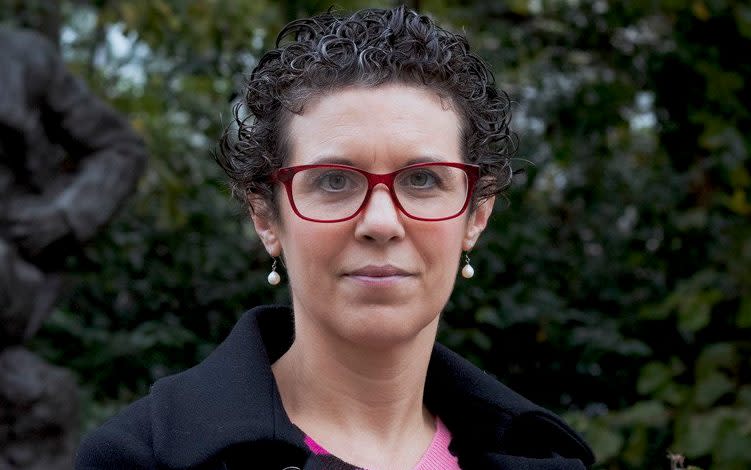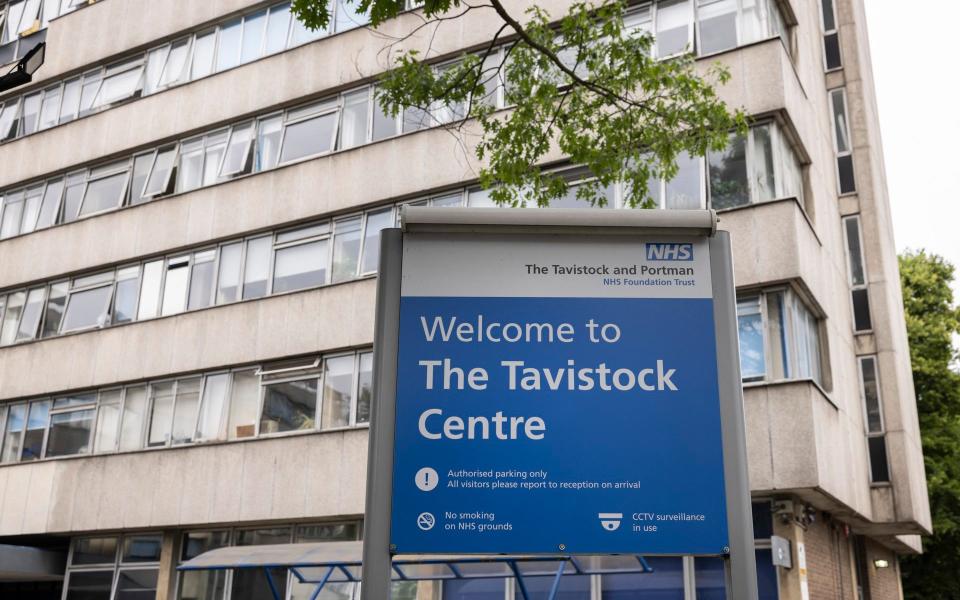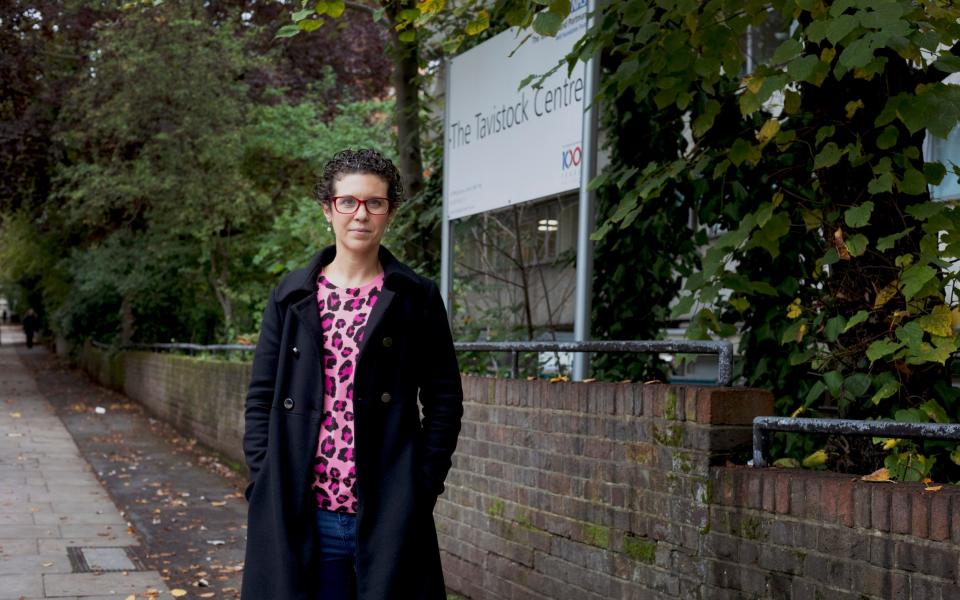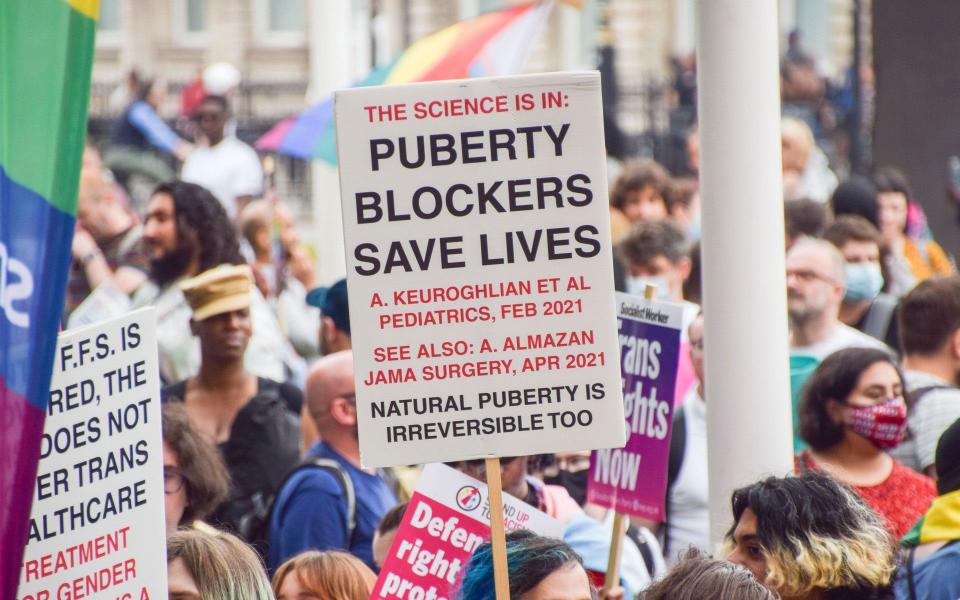I spent years investigating the Tavistock clinic – I have serious concerns about its replacement

There hasn’t been much to smile about since I began researching and writing about the care provided to young people struggling with their gender identity. So, when I heard again from Harriet, a young woman who had been badly let down by both youth and adult NHS gender services, to say that she is thriving, it was welcome news.
When we first spoke, almost two years ago, Harriet was living with the consequences of taking testosterone and having a double mastectomy, both of which she regretted. At the time she was 21 and no longer identified as trans. She had begun a process known as detransitioning (the stopping or reversal of a transgender transition).
Back then, Harriet felt ‘stuck’, frustrated and angry at what she felt could have been avoided had her clinicians had more curiosity and rigour when she first went to them to say she identified as male. Now, at 23, she is much happier. ‘I [feel] able to properly be myself for the first time since detransitioning,’ she says. ‘I wish I could tell my [younger self] that things aren’t so bad!’ Today she has a new job and new friends who don’t know about what she calls her ‘weird history’.
But, while Harriet is now content – despite all that she’s been through – the situation facing young people in England and Wales who are questioning or experiencing distress around their gender identity could scarcely be worse. More than 8,000 children are on the waiting list for help. Thousands more 16- and 17-year-olds have been removed from that list, and told they’ll instead need to decide if they want to be seen in adult gender clinics. Having waited for years in some cases, they’ll never be seen in youth services.
There is no new help available on the NHS. The long-awaited new gender services for young people have been delayed further, with confirmation last month that the first of two regional hubs will not open this autumn as planned. That target was already six months later than what had been originally announced.
The only existing NHS gender clinic for children and young people – the Gender Identity Development Service (GIDS) at the Tavistock and Portman NHS Foundation Trust – has been earmarked for closure by NHS England since July 2022.
In the decade before, referrals to GIDS had exploded from the hundreds to the thousands. The service struggled to cope. A number of its staff had also voiced serious concerns that the way the service was operating wasn’t always safe: that assessments were too quick and that children and young people were sometimes being referred for puberty blocking drugs without other difficulties in their lives being explored adequately first; sometimes after appointments totalling just a couple of hours.
GIDS is currently seeing around 1,000 children but isn’t taking on new patients. It has been rated ‘inadequate’ by inspectors from healthcare regulator the Care Quality Commission (CQC), and its model of care found to be wanting by an independent review of gender identity services, led by the highly respected paediatrician Dr Hilary Cass.
A new London NHS Children’s and Young People’s Gender Service is now set to open, along with another in the north of England in April 2024. They will be partnerships between children’s hospitals and others offering mental health support. Like GIDS, they’ll be overseen by NHS England.
When Great Ormond Street Hospital, one of several hospital trusts involved in the new service, confirmed to me the most recent delay, it said: ‘The set-up of this completely new service is complex’ – a true British understatement. It is an unenviable task. But one that has not been helped by a seeming reluctance to break fully from the past and follow a completely new model, underpinned by Dr Cass’s interim report, published in February 2022, and a new interim service specification published by NHS England.
These call for a different approach to helping this group of young people, one where other difficulties are considered alongside their gender-related distress, and where the first-line treatment should be therapeutic, not medical.
I reported earlier this year for the BBC’s Newsnight that current GIDS staff committed to the service’s original approach – what Dr Cass called a predominantly ‘non-exploratory’ one – have been recruited to key roles in the new London hub, along with those who on personal blogs have openly questioned Dr Cass and NHS England’s more cautious stance on social transition. (This is where a young person might change their name, pronouns and way they dress.)
Another member of the new education team, responsible for developing materials that’ll be used to train new recruits, is paediatric endocrinologist Professor Gary Butler – the current clinical lead for GIDS. His team at University College London Hospitals have been responsible for prescribing puberty blockers and hormones. In a recording passed to me in May, Professor Butler can be heard questioning the need for any change in approach and appearing to accuse Dr Cass of ‘nepotism’. In a 14-minute conference speech, he said he felt GIDS has been the subject of ‘lies’ in the media.
Later he told the BBC the reporting of his comments was ‘highly selective’ and that he fully supported Dr Cass’s recommendations.
Great Ormond Street’s spokesperson has said they want to ‘recruit a wide range of people’. But this wide range includes those who blew the whistle on what they saw as unsafe practices at GIDS. So, the whistleblowers are working alongside those they blew the whistle on – and within a service model they blew the whistle on.

It’s a striking approach to take, and may explain the difficulty in getting the service up and running. The task has no doubt been made more difficult not just by recruiting some people who seem reluctant to acknowledge the mistakes of the past, but also by the fact that these mistakes weren’t tackled quickly enough.
One standout part of the story of GIDS is the number of missed opportunities to do things differently: in 2005, Susan Evans, a former psychiatric nurse, was the first to raise concerns that some clinicians appeared to be referring young people for puberty blockers too quickly.
She became concerned after a colleague told her they had referred a distressed 16-year-old boy for puberty blockers after four appointments. ‘I used to come home and just say… “This service is not right. This is just not right. I’m really worried about some of these kids,”’ she told me.
The concerns were investigated, but recommendations to improve GIDS, particularly by collecting data and following up with patients, were largely ignored.
Another opportunity came in 2015 when an independent consultant was brought in to help GIDS manage ever-increasing referrals. In five years, these had grown from 139 to 1,419. Her report described staff under intense pressure – the current model of working was ‘unsustainable’ – and she recommended that GIDS should ‘[cap] the number of referrals immediately’ to rethink what it could offer. It didn’t happen.
The findings were shared with only a small group of senior staff. According to one, Dr Anna Hutchinson, GIDS could have been the first team to develop a more nuanced assessment process to acknowledge the young people being referred were changing, and that maybe they needed different treatments. ‘We could have changed the whole story of what was going on. Not just have [made GIDS] a better clinical service, but actually had an impact on global [gender clinic] practice and society,’ she says.
It’s a sobering thought. How different could things have been if there had been a change in direction eight years ago?

Recently I attended a conference in New York, hosted by Society for Evidence Based Gender Medicine (SEGM), a US-based non-profit, where I was asked to give a presentation on ‘lessons from the largest youth gender clinic in the world’ – for that’s what GIDS was.
One lesson I suggested was to seize opportunities to change. This struck a chord with some.
‘Had they acted on that, my clinic might never have even opened,’ said Jamie Reed, tears in her eyes.
Reed, who had been a case manager at a service affiliated to Washington University, was branded the USA’s first gender clinic whistleblower after going public with her concerns. Many were similar to those raised by GIDS clinicians. Washington University has defended its practices, saying its staff have ‘cared for these patients with skill and dedication’.
‘I was shaken by seeing the timeline so clearly and what that silence from GIDS meant for the rest of the world,’ Reed told me afterwards. But this ‘silence’ wasn’t repeated everywhere.
The conference was attended by professionals from other youth gender clinics around the Western world, which – like GIDS – have also received a rapid increase in referrals. And, like GIDS, they have seen a significant shift in the demographics of the young people being referred. But clinics in other parts of Europe responded in a very different way.
In 2015, Finnish clinicians wrote that the young people coming forward to use their services were very different to those reported by the Dutch team that had pioneered the medical approach to treatment of gender dysphoria in young people.
Specifically, more than 85 per cent of those referred in Finland were natal girls; most had ‘first presented with gender dysphoria… well after the onset of puberty’; 13 per cent were living in care or independently. And, most startling, some three quarters ‘had been or were currently undergoing child and adolescent psychiatric treatment for [other] reasons when they sought referral’. The young people referred to GIDS in England were very similar. But neither they nor the Finnish teenagers were anything like the young people of the landmark Dutch studies, in which the majority of patients did not have other significant problems. Indeed, young people starting a medical transition in the Netherlands had to be free of any other major psychological difficulties, have a stable home life, and had to have reported gender difficulties from childhood.
The Finns couldn’t explain why their young people appeared to be so different; but they knew that if the patients weren’t the same, maybe the treatment shouldn’t be the same either.
In Finland, unlike in England, it was the leadership of the gender clinics who called for change – one Dr Riittakerttu Kaltiala, chief psychiatrist at one of Finland’s two government-approved paediatric gender clinics. Her team instigated a systematic review of the evidence and new guidelines for care were written.
Dr Kaltiala was also at the SEGM conference in New York. She reported the findings of the data they had collected on how young people treated with puberty blockers and hormones had fared. Not that well, it seems.
Since 2020, the Finns have viewed the use of medical interventions to treat gender distress in young people with caution. Psychotherapy is the first-line treatment, and while medical transition is allowed, it’s mostly for those whose gender dysphoria began in early childhood and who have no co-occurring mental health conditions.
Listening to Dr Kaltiala, I had to ask: why was she able and willing to call for a review in response to the changing emerging evidence, when the leaders at GIDS were not? There it was left to whistleblowers raising concerns; first internally, then to the wider Tavistock Trust, and finally to the media. Some were vilified in the process.
Dr Kaltiala was diplomatic in her response: Finland is a much smaller country, she pointed out. It wasn’t receiving the number of referrals GIDS was, and the change in demographics was ‘so obvious’. Plus, the Finns didn’t have the ‘weight of history’ that GIDS had. She didn’t elaborate further.
The approach now advocated, years later, by NHS England and the Cass Review team is similar to Finland’s. Just as in Finland, a systematic review of the evidence base for using puberty blockers and cross-sex hormones to treat young people with gender dysphoria has been undertaken. And, just as in Finland, that evidence base was judged to be of ‘very low’ certainty.
The aim in England is now to only prescribe puberty blockers as part of a clinical trial and in exceptional cases (there’s no detail yet on how the latter will be judged). In Sweden, young people will only receive puberty blockers as part of clinical trials too. Norway may take a similar approach, and in France and Denmark health authorities have also expressed caution about medical transition in under-18s.
In sharp contrast is the approach of the US. There, the issue is even more contentious – accusations of being ‘transphobic’ thrown around more frequently. Even clinicians who have devoted their professional lives to working in youth gender clinics and recommended patients for medical treatments can be ostracised for suggesting that puberty blockers and hormones won’t help every one of these young people.
American psychologists Dr Erica Anderson and Dr Laura Edwards-Leeper, who spoke in New York, are viewed as traitors by some, apparently for urging their colleagues to undertake comprehensive assessments before recommending powerful medications. This, despite the fact that Dr Anderson, a former president of the US Professional Association for Transgender Health, is herself a trans woman; Dr Edwards-Leeper was the founding psychologist at the US’s first youth gender clinic.
As for the conference organisers, SEGM has been branded ‘anti-trans’ by some. I saw no evidence of this. The conference venue was kept secret to protect those taking part; some had stated on social media that they planned to disrupt the event.
I am a cautious journalist. I’m sometimes criticised for it. I did my homework before agreeing to take part, and before the BBC, as my then employer, gave me permission to do so. Members of the organising committee answered every question I had, including who funded them. And it’s not ‘far-Right, Christian evangelicals’. Faith was entirely absent from the conference. Most attendees work, or previously worked, directly with gender-questioning children. Hundreds, if not thousands, of them. Others were academics and experts in evidence-based medicine.
Whatever anyone present at the conference thought about the best way to help gender-questioning youth, everyone agreed that they deserved good evidence-based care.
But one clinician who has worked in this field for many years approached me after I’d left the conference room for some fresh air and challenged me. In my presentation that morning I’d said that ‘data must be collected to inform best practice’, a statement I saw as uncontroversial. This clinician told me it was naive to think clinicians should follow up every single person who’d been through therapy. This was different though, surely, I countered? This involved children and the use of powerful drugs about whose long-term consequences we know little. We agreed to differ.

Professor Sallie Baxendale, a consultant clinical neuropsychologist at University College London, overheard the exchange. ‘You’re right,’ she said. She is involved with NHS England’s Children’s Epilepsy Surgery Service and explained: ‘There are a lot of parallels with gender “care”. Epilepsy surgery is elective and has significant, lifelong side effects.’
Follow-up, she told me, was essential and expected.
More than 3,000 children have been assessed for epilepsy surgery since she started in the service. All of them are monitored. As she says, monitoring ‘should be the minimal model for all elective treatments with the potential for significant harm’.
Is it really too much to ask that gender-questioning young people be afforded that same standard of care?
And yet some charities and politicians appear to see scrutinising the care provided to gender-questioning young people as illegitimate. When I first started covering this area of healthcare for Newsnight, along with my then-colleague, Deborah Cohen, we faced criticism. We never questioned the identities of young people or their right to transition.
But perhaps this is why the giants of publishing did not want to take the topic on. When I first wrote my book about it, Time To Think, my proposal was turned down, or ignored, by 22 publishers. Or maybe they were frightened by a backlash that, thankfully, has not materialised.
Instead, it has allowed for the beginning of a calm conversation on how best to care for gender-questioning young people. This has shown me that it is possible to have an evidence-based, critical conversation about this topic, while at the same time being compassionate. It does no one any good to pretend that mistakes have not been made.
Things have improved since I began researching this subject in 2019 – but there is still a fear of publicly discussing or probing it. Even though the book is a bestseller, only one literary festival invited me to speak – Cheltenham. Another booked me, and later cancelled citing a ‘scheduling issue’.
The truth is that while some young people insist they have been helped by a flagship specialist NHS service, others have most certainly been harmed. To deny either position a voice would be wrong. Because after all, unlike other medical failures, this is a story yet to finish.
Time To Think, by Hannah Barnes, is shortlisted for the Baillie Gifford Prize for Non-Fiction 2023; the winner will be announced Thursday, November 16.

 Yahoo Movies
Yahoo Movies 
